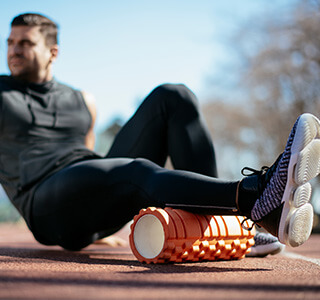Common Foam Rolling Mistakes You Are Probably Making
Whether you just completed a brutal HIIT class or just broke your max lift, your muscles are going to be sore after an intense workout. If you don’t give your body some rest and recovery time, you’re setting yourself up for a potential injury.
A common relief to those sore muscles is a foam roller. A foam roller can hit your muscles at multiple angles and is able to target fascia – the connective tissue that surrounds your bones, muscles, and joints – that can get tight.
Foam rolling seems pretty self-explanatory but if you are not rolling the correct way you can subject yourself to additional pain.
Read these 7 tips to find out if you are using the foam roller incorrectly.
Using the wrong pressure
Using too much or too little pressure will hinder your ability to repair your damaged muscle tissue appropriately. A slower to medium speed may be more effective at releasing tension without causing excess strain.
Different muscles have different trigger points and tightness. Avoid using the same pressure for every spot. Listen to your body and apply pressure accordingly. It can be difficult to know which pressure is best. Rolling shouldn’t feel comfortable, especially when you’re hitting trigger points. So, if you don’t feel anything while rolling you may be using too light of pressure. On the other side, if the pain is excruciating, you may want to pull back a little bit. Additionally, don’t roll too fast over each section.
Spending too long on a specific area
If you feel a really tense spot you may be tempted to spend a long time rolling it out. Personal trainers recommend spending anywhere from 30 seconds to a minute on an area. For 30 seconds, put the muscle on the roller and apply consistent pressure, then spend another 30 seconds to one minute on dynamic pressure. Dynamic pressure means moving the foam roller across the muscle, as opposed to static pressure, which is keeping the roller in one spot. To fully explore the fascia, keep the roller in place as you twist from side to side and then move your body up and down the length of the muscle, so you move as it moves.
Rolling a “cold” muscle
A “cold” muscle is a muscle that has not been warmed up through activity. Rolling in one spot for too long can increase your risk of bruising and injury. However, rolling a “cold” muscle is much safer than the static and dynamic stretching of a cold muscle. If you roll a cold muscle, ease into it with softer pressure. Doing this will avoid causing inflammation and further fascia damage. Applying too much pressure to a “cold” muscle can damage muscle tissue and make your aches even worse. Keep the roller still and shift your body gently, allowing the body to warm up a bit to loosen tense points.
Only rolling in one direction
If you only roll vertically, you are missing all of the fasciae that run horizontally. First, keep the roller stationary and twist from side to side. Then, roll the length of the muscle.
Attacking knots right away
Loosening up the fascia above and below the knots will make loosening the much easier. Knots usually form at trigger points, which can cause an acute pain because they hold a great amount of tension. If you start to experience tingling, pulsing, or limbs “falling asleep,” move your location or change positions. These indicate you’re pressuring your nerves improperly or limiting blood flow.
Rolling the wrong areas
Not all muscles are fair game when using the foam roller. The biggest mistake you can make when foam rolling is rolling your iliotibial, or IT, band. The IT band is actually a thick band of ligament that cannot be loosened. If your IT band is tight, focus on rolling the glutes, quads, and around the knee. Then do direct strengthening and physical therapy designed to strengthen the glutes, in turn taking pressure off the IT band.
Other areas to avoid are the lower back, neck, and pubis region. These areas do not have dense enough muscle to safely and effectively roll. Instead of foam rolling your lower back, opt for a tennis ball.
Starting in the wrong place
If you are working out, you wouldn’t go from standing to sprinting, and the same is with foam rolling. Start rolling from a place of comfort toward discomfort. So, pick your least-tight areas to start with and move your way to the tensest. Try not to move too quickly from one muscle group to the next.
When beginning to roll a specific area, start at the origin of the muscle and slowly roll to the insertion of the muscle. This will release the fascia comfortably and effectively. A good rule of starting with the origin is to start rolling closest to the core and roll away.
